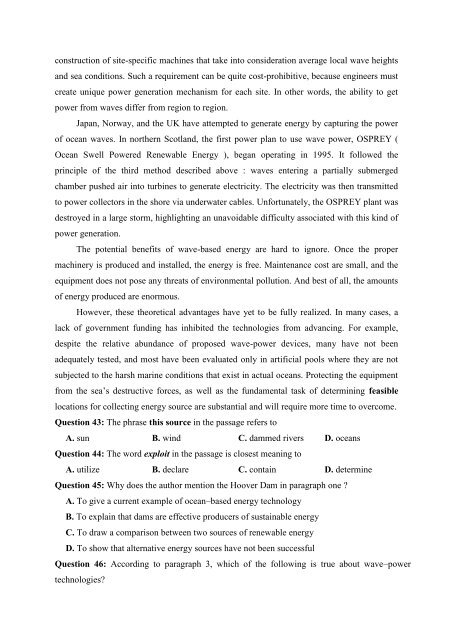Bộ đề thi thử THPTQG năm 2018 - Môn Tiếng Anh - 20 ĐỀ + ĐÁP ÁN - GV Kiều Thị Thắng - Tuyensinh247
https://app.box.com/s/fdml0d4t6lk8t30qzh0xow50qpjgs63c
https://app.box.com/s/fdml0d4t6lk8t30qzh0xow50qpjgs63c
You also want an ePaper? Increase the reach of your titles
YUMPU automatically turns print PDFs into web optimized ePapers that Google loves.
construction of site-specific machines that take into consideration average local wave heights<br />
and sea conditions. Such a requirement can be quite cost-prohibitive, because engineers must<br />
create unique power generation mechanism for each site. In other words, the ability to get<br />
power from waves differ from region to region.<br />
Japan, Norway, and the UK have attempted to generate energy by capturing the power<br />
of ocean waves. In northern Scotland, the first power plan to use wave power, OSPREY (<br />
Ocean Swell Powered Renewable Energy ), began operating in 1995. It followed the<br />
principle of the <strong>thi</strong>rd method described above : waves entering a partially submerged<br />
chamber pushed air into turbines to generate electricity. The electricity was then transmitted<br />
to power collectors in the shore via underwater cables. Unfortunately, the OSPREY plant was<br />
destroyed in a large storm, highlighting an unavoidable difficulty associated with <strong>thi</strong>s kind of<br />
power generation.<br />
The potential benefits of wave-based energy are hard to ignore. Once the proper<br />
machinery is produced and installed, the energy is free. Maintenance cost are small, and the<br />
equipment does not pose any threats of environmental pollution. And best of all, the amounts<br />
of energy produced are enormous.<br />
However, these theoretical advantages have yet to be fully realized. In many cases, a<br />
lack of government funding has inhibited the technologies from advancing. For example,<br />
despite the relative abundance of proposed wave-power devices, many have not been<br />
adequately tested, and most have been evaluated only in artificial pools where they are not<br />
subjected to the harsh marine conditions that exist in actual oceans. Protecting the equipment<br />
from the sea’s destructive forces, as well as the fundamental task of determining feasible<br />
locations for collecting energy source are substantial and will require more time to overcome.<br />
Question 43: The phrase <strong>thi</strong>s source in the passage refers to<br />
A. sun B. wind C. dammed rivers D. oceans<br />
Question 44: The word exploit in the passage is closest meaning to<br />
A. utilize B. declare C. contain D. determine<br />
Question 45: Why does the author mention the Hoover Dam in paragraph one ?<br />
A. To give a current example of ocean–based energy technology<br />
B. To explain that dams are effective producers of sustainable energy<br />
C. To draw a comparison between two sources of renewable energy<br />
D. To show that alternative energy sources have not been successful<br />
Question 46: According to paragraph 3, which of the following is true about wave–power<br />
technologies?


















